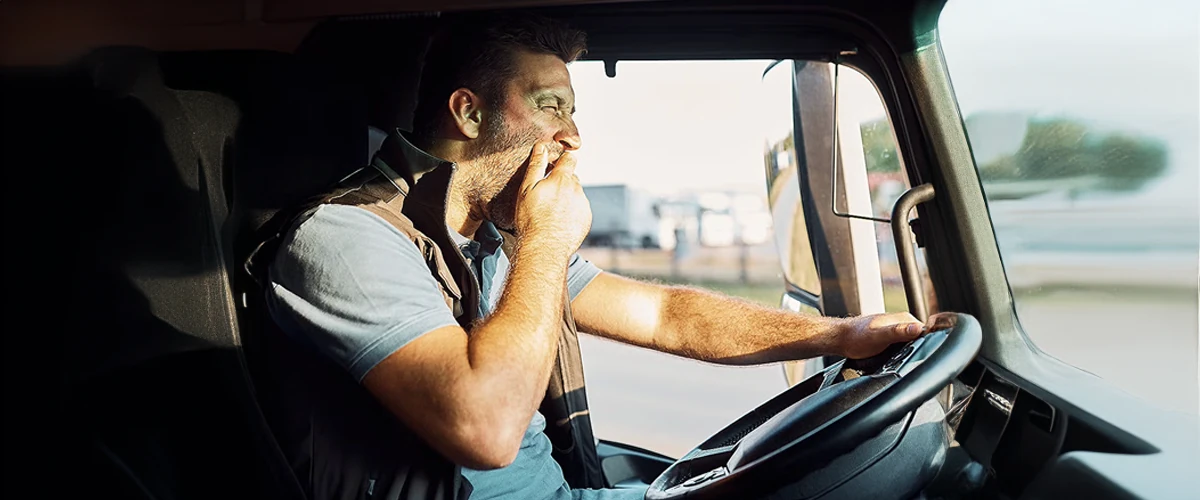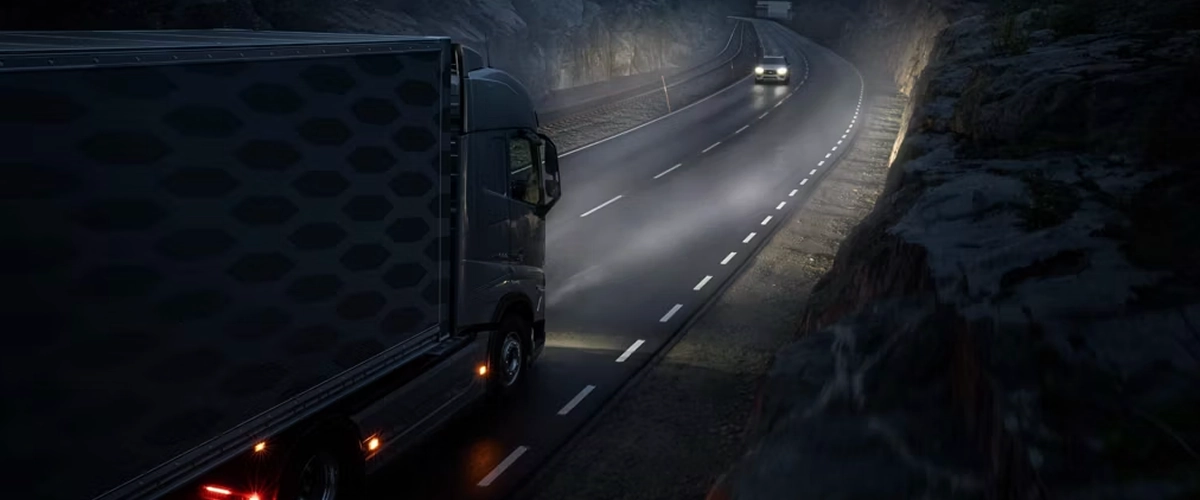
To navigate safely through the darkness and reduce the heightened risk of accidents due to decreased visibility, this article offers ten essential tips for driving at night.
Table Of Contents
Key Takeaways
- Nighttime driving demands heightened vigilance due to increased risks such as reduced visibility, driver impairment, and drowsiness.
- Maintaining clear visibility through clean windshields and properly functioning headlights is crucial for safe night driving.
- Regular eye checkups and appropriate use of vehicle lights like high beams and dashboard lights can significantly enhance nighttime driving safety.
Introduction
Driving at night transforms the world into shades of gray, introducing dangers that are seldom faced during daylight hours. The National Highway Traffic Safety Administrationhas highlighted a grim statistic: fatal accidents are twice as likely to occur after the sun sets. For those behind the wheel of big rigs, it becomes imperative to exercise increased caution while traversing nocturnal roads. With driver intoxication rates surging in darkness and visibility sharply decreasing, every obscure corner may hide looming threats.
Navigating nighttime roadways presents a multifaceted challenge fraught with fatigue, diminished visual acuity under low light conditions, and the blinding glare from headlights of approaching vehicles. To ensure their safety on these shadowy thoroughfares, drivers must engage in vigilant driving practices—ever-alert for any sign of trouble on streets shared with other creatures and humans—and grapple with ever-fluctuating levels of sight, which can be drastically altered by encounters with cars bearing down from opposite directions.
Stay Extra Alert

When the cloak of night descends, every passing headlight becomes a potential threat to your well-being. The National Highway Traffic Safety Administration’s stark statistic that fatal accidents are three times more likely at night should be etched in the mind of every driver. With the reduced light from street lights, sharp curves, and the undulating terrain of two-lane highways, the glare from oncoming vehicles can be more than just an annoyance—it can be a downright dangerous bright light. In fact, the National Safety Council emphasizes the importance of being extra cautious during nighttime driving.
As night falls, so does the guard of some drivers, leading to impaired judgment and slower reaction times. This necessitates an elevated state of alertness, where anticipating the actions of impaired drivers and oncoming drivers becomes as crucial as watching the road ahead. Being extra defensive at night isn’t just a precaution; it’s a survival tactic.
Combat Driver Fatigue
Drivers who traverse long distances can be lured into complacency by the monotonous rhythms of the road and the steady drone of their vehicles, a dangerous situation for those who are already fatigued. Battling fatigue is an essential challenge for truckers, especially when they drive through the night. A proactive defense against this relentless adversary involves ensuring that one secures a good seven to eight hours of sleep prior to setting off on nighttime drives.
To maintain mental acuity and ward off sleepiness, it’s crucial for drivers to eat modestly and refrain from consuming alcohol. Introducing regular breaks approximately every three hours allows them an opportunity to stretch their legs and refresh their faculties. Should resistance against drowsiness become futile, taking a brief nap in a secure area may prove critical—it could mean the difference between reaching your destination safely or risking not reaching it at all.
Maintain Clear Visibility
Maintaining a clear line of sight is crucial when navigating the hazards that come with driving at night. When your windshield is coated in dirt and debris, oncoming headlights can create a blinding glare that drastically reduces your response time to unexpected road conditions. It’s essential to keep both mirrors and the windshield as transparent as possible, ensuring vision remains sharp and travel stays safe during nocturnal journeys.
The lights of your vehicle need to be in excellent working order. Regular checks and upkeep of both low beam and high beam headlights, along with other important signal functions, are key not only for illuminating the path you’re traversing, but also for effective communication with fellow motorists sharing the roadway.
Adjust Headlights Correctly
The light from your vehicle’s high beams serves as its vision, piercing the darkness and unveiling the route ahead. Making sure that they are properly adjusted is not only thoughtful towards other drivers, but also an essential element of highway safety. Headlights can become misaligned due to a variety of reasons such as changes in cargo load or general wear and tear, leading to either insufficient road lighting or worse, temporarily blinding other drivers at night.
Conducting regular inspections for proper alignment of your headlights can ward off these issues. By positioning your truck 25 feet away from a wall and examining how the light casts its pattern, you’ll be able to adjust them appropriately when necessary. Striking for this balance ensures that while using high beams you’re well-lit on your path without encroaching on the sightline of fellow motorists.
Use High Beams Wisely

High beams play a crucial role for drivers navigating through the darkness on sparsely lit roads, exposing potential hazards that lurk in the night. Their use should be balanced with consideration for others. When no other vehicle is present and visibility is poor, high beams become an essential asset to illuminate the road ahead. When another vehicle appears within a distance of 500 feet coming toward you—switching to low beams is both courteous and necessary.
It’s important not only to avoid using high beams around bends and over hills where they can actually impede rather than help vision, but also to lower them at intersections so as not to dazzle fellow motorists temporarily. By using your truck’s high beam headlights judiciously during nighttime driving conditions, everyone’s journey remains safe and pleasant.
Modify Dashboard Lights
The illumination from your truck’s dashboard lights, while faint, can be an important source of distraction. By reducing the brightness of these interior lights, you achieve two benefits: maintaining visibility of crucial controls and harmonizing with the external darkness. Utilize the dimmer switch on your dashboard to cut down distractions and lessen eye fatigue so that you are able to maintain attention on navigating the road ahead.
By employing sun visors at night, one can combat not only street lighting glare but also that from vehicles approaching in opposing lanes. Sun visors help preserve your night vision by blocking out intrusive bright lights outside your vehicle—this is vital for ensuring safety as you steer among other cars in nocturnal conditions.
Slow Down and Increase Following Distance
When darkness envelops the environment, it becomes more difficult to gauge distances and identify potential hazards on the road. Consequently, decelerating is not merely a suggestion, but an essential modification needed to manage these nighttime conditions. By easing up on the gas pedal, you grant yourself additional critical moments to respond effectively should an abrupt halt occur ahead or wildlife appear unexpectedly.
Maintaining a safe gap between your car and others is vital in guarding against unforeseen events. While daylight driving typically warrants a two-second separation from the vehicle ahead of you, increasing this interval to three seconds at night creates an increased safeguard for your well-being. It’s important to remember that higher speeds equate with longer stopping distances. Hence be sure to modulate both your velocity and spacing suitably as circumstances dictate.
Watch for Wildlife
Life flourishes at night, yet we might not be aware of it until wildlife suddenly appears in the beams of our vehicle headlights. This is especially true in areas less touched by human activity, where animals can unexpectedly cross your path. To anticipate these encounters, pay attention to signs indicating animal crossings. And keep in mind that spotting one creature often means others could be close.
Should an animal venture onto the road before you, curb the instinct to swerve. Your safer course of action is to decelerate steadily while keeping your vehicle stable—avoiding a locked-wheel situation—to retain control. Swerving has the potential to create a scenario more dangerous than hitting the animal itself.
Regular Eye Checkups
Vision is paramount for a driver, especially during night driving when darkness envelops the roadways. Ensuring compliance with legal driving vision requirements through frequent eye examinations is not just a regulatory matter—it’s essential for maintaining safety on the roads. These exams play a crucial role in detecting and addressing any visual impairments that might hinder one’s nighttime driving capabilities.
With age, changes to vision can notably impede one’s ability to manage depth perception and distinguish colors—factors critical to safe night driving. To effectively tackle the demands of navigating at night, it’s important to keep your eyesight in optimal condition.
Stay Prepared for Emergencies
The unpredictable nature of night driving calls for a well-prepared emergency kit. Here are some essential items to include:
- A flashlight
- Reflective triangles
- Road flares
- A first aid kit
- Non-perishable food
- Water
Having these items on hand can make all the difference in case of an unexpected stop or other unforeseen circumstances.
Regularly updating your emergency kit can ensure that you’re ready for any situation you might encounter on the road. Some items to consider adding to your kit include:
- Blankets
- Ice scraper
- Extra clothes
- Flashlight
- First aid kit
- Non-perishable food
- Water
The readiness to handle emergencies is a testament to a truck driver’s commitment to safety.
Summary
During the tranquil moments of driving at night, readiness and watchfulness are your guardians on the road. Ensuring you remain attentive, keep a clear line of sight, and prepare for unforeseen situations will allow you to traverse through the night assuredly. Paying attention to personal well-being, vehicle maintenance, and sensory sharpness ensures that if you look after the road ahead.
As your nighttime journey progresses, carry with you these insights and tactics as guiding lights along your way. Tread carefully yet confidently with an understanding that you possess all necessary tools to overcome nocturnal driving obstacles. Wishing safety upon your travels—may they be free from harm—and may favor grace each route taken during those quiet hours under starry skies.
Frequently Asked Questions
How can I reduce the risk of fatigue during long nighttime drives?
Ensure you acquire sufficient rest before embarking on extended night drives to minimize the risk of fatigue. Regularly pause for stretching and activity, and avoid consuming substantial meals and alcohol to preserve alertness.
What should I do if my headlights are not aligned correctly?
To correctly adjust your truck’s misaligned headlights, position it 25 feet away from a wall. Then utilize the horizontal and vertical adjustment screws to align the beams properly so they provide adequate illumination without impairing the vision of other drivers.
When should I use my high beams while driving at night?
When you’re driving in dimly lit areas and there isn’t any oncoming traffic within 500 feet or a vehicle ahead of you, it’s appropriate to utilize your high beams. Likewise, if you are following another vehicle but maintain at least 200 feet of distance, high beams can be used. Always remember to switch to low beams when approaching oncoming vehicles, navigating intersections, or while driving around curves.
How often should I have my eyes checked for optimal night driving?
To ensure compliance with legal requirements and to resolve any problems that could compromise safe driving during the night, it is advised to undergo eye examinations biannually.
Maintaining optimal eyesight for night-time vehicle operation necessitates routine vision screenings.
What items are essential for a truck driver’s emergency kit?
Ensure that your emergency package contains a flashlight, batteries, reflective triangles, road flares, robust jumper cables, necessary tools, a medical aid kit, an emergency thermal blanket, as well as water and food items that have long shelf lives.
By doing so you can be ready for any circumstance you might encounter while driving.

